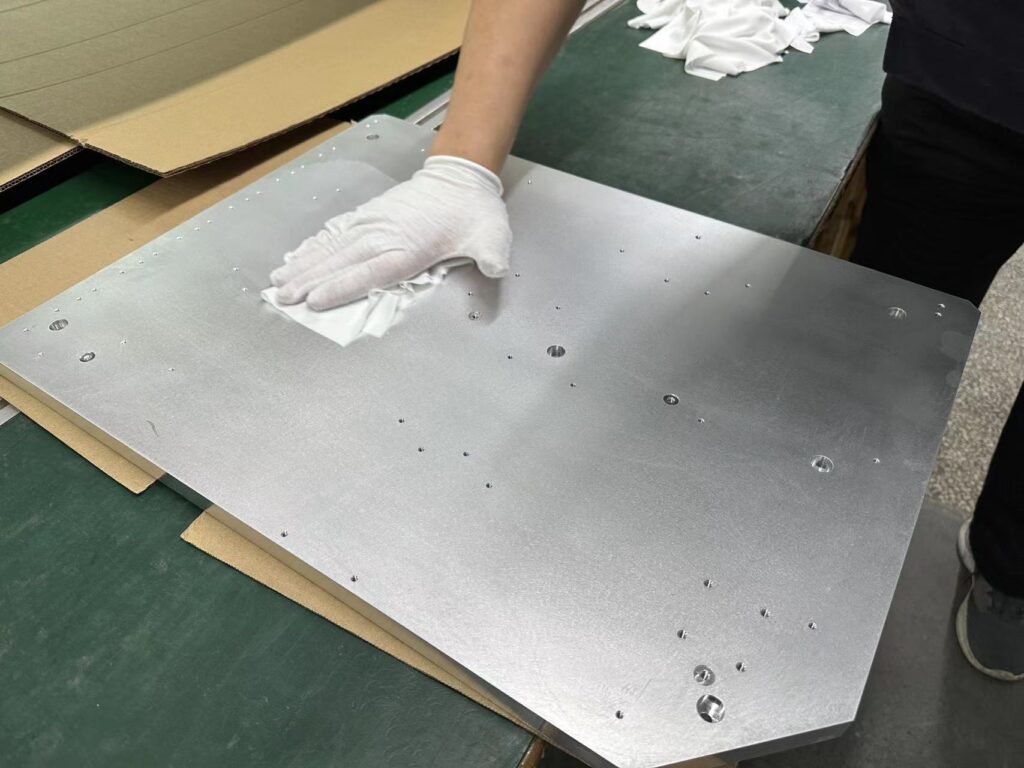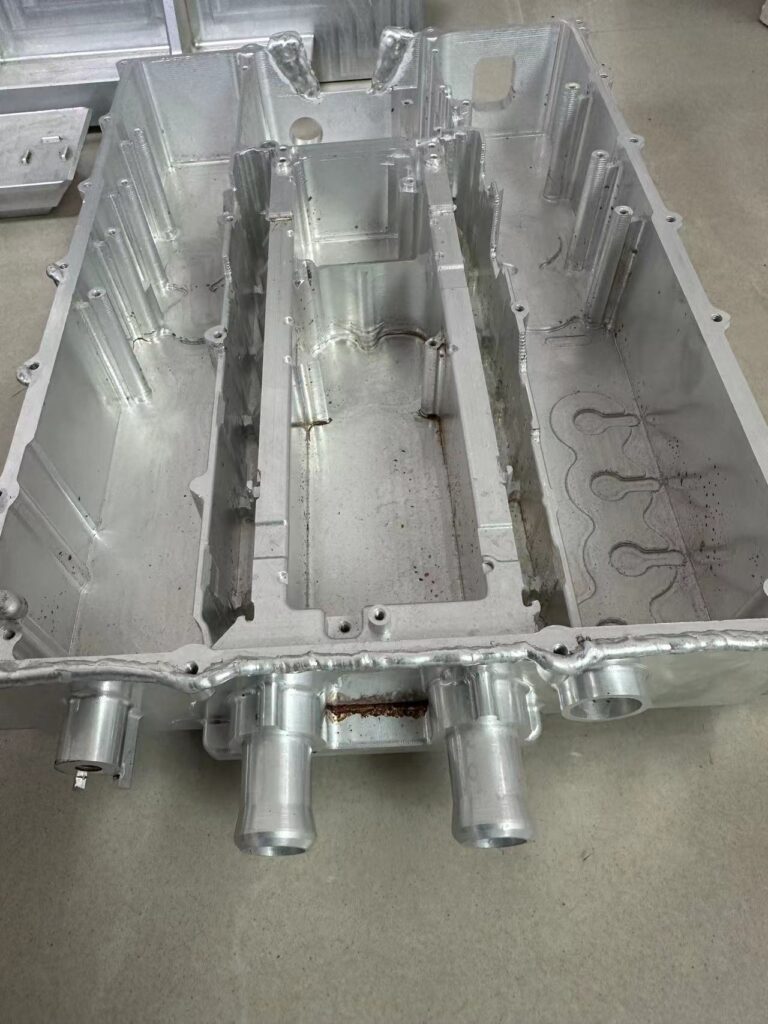Introduction
In today’s industrial landscape, the efficient management of heat is paramount across various sectors. From electronics to automotive, aerospace to energy, the demand for effective thermal management solutions continues to rise. The humble yet indispensable component known as the heat sink is at the heart of this demand.
Heat sinks are the primary means of dissipating excess heat generated by electronic components, machinery, and processes. Heat sinks play a critical role in preventing overheating and ensuring the reliability and longevity of equipment by transferring thermal energy away from sensitive components.
Brazing process is a versatile and efficient method among the myriad techniques employed in heat sink fabrication. Brazing involves joining metal components using a filler material that melts above 450°C (840°F) but below the melting point of the base metals. This process results in solid, durable bonds capable of withstanding high temperatures and mechanical stress.
However, the effectiveness of brazing heat sinks is not solely determined by the brazing process itself; instead, it hinges mainly on the materials chosen for construction. This is particularly crucial in extreme temperatures, corrosive atmospheres, or mechanical vibrations. In such harsh conditions, selecting the appropriate materials can distinguish between optimal performance and premature failure.

Understanding the Operating Environment for Brazing Heat Sinks
1. Definition of “Harsh Environments” in Heat Sink Applications
In heat sink applications, “harsh environments” refer to extreme temperatures, corrosive atmospheres, and mechanical stress. These environments pose significant challenges to the performance and longevity of heat sinks, requiring robust solutions to ensure effective thermal management.
2. Common Challenges Faced by Heat Sinks in Harsh Environments
High Temperatures
One of the primary challenges faced by heat sinks in harsh environments is the presence of high temperatures. In industrial settings such as power plants or automotive engines, temperatures can soar to levels that exceed the operating limits of conventional materials. As a result, heat sinks must be capable of withstanding elevated temperatures without compromising their structural integrity or thermal conductivity.
Corrosive Atmospheres
Corrosive atmospheres, often encountered in marine or chemical processing environments, pose another significant challenge to heat sinks. Exposure to moisture, saltwater, acids, or other corrosive agents can lead to material degradation and surface corrosion, ultimately impairing the performance of the heat sink. To combat this issue, materials with high corrosion resistance are essential for ensuring long-term reliability.
Mechanical Stress
Mechanical stress, including vibration, shock, and mechanical loading, can also impact the performance of heat sinks in harsh environments. In aerospace or heavy machinery applications, heat sinks may be subjected to constant movement or mechanical shocks, leading to fatigue failure or joint loosening. Therefore, heat sinks must be constructed using materials and designs that can withstand mechanical stress and maintain structural integrity under dynamic conditions.

Key Material Selection Criteria for Brazing Heat Sinks
1. Thermal Conductivity
Thermal conductivity plays a crucial role in the effectiveness of heat sinks for dissipating excess heat generated by electronic components or industrial processes. Materials with high thermal conductivity facilitate efficient heat transfer, allowing heat to be quickly conducted away from the heat source and dispersed into the surrounding environment. This property is significant for brazing heat sinks, as it ensures that the heat generated by the components is effectively dissipated, preventing overheating and maintaining optimal operating temperatures. When selecting materials for brazing heat sinks, prioritizing those with high thermal conductivity can significantly enhance their performance and reliability.
2. Corrosion Resistance
In harsh environments where brazing heat sinks may be deployed, exposure to corrosive substances such as moisture, chemicals, or saltwater can accelerate material degradation and compromise the integrity of the heat sink. To mitigate this risk, choosing materials with high corrosion resistance is essential. These materials can withstand prolonged exposure to corrosive environments without significant degradation, ensuring the long-term reliability of the brazing heat sink. By prioritizing corrosion-resistant materials during the material selection process, brazing heat sink manufacturers can enhance the durability and longevity of their products, even in the face of challenging operating conditions.
3. Mechanical Strength
Mechanical strength is another critical consideration when selecting materials for brazing heat sinks, especially in applications where mechanical stress, vibration, or shock may be prevalent. Heat sinks must withstand these mechanical forces without experiencing deformation, fracture, or joint failure. Therefore, it is imperative to choose materials with sufficient mechanical strength to endure the rigours of the operating environment. By selecting materials that exhibit high mechanical strength, brazing heat sink manufacturers can ensure their products’ structural integrity and stability, thereby enhancing their reliability and performance in demanding applications.
4. Compatibility with Brazing Process
Finally, the compatibility of materials with the brazing process is a crucial factor to consider during material selection for brazing heat sinks. Not all materials suit brazing techniques; some may exhibit poor wetting or bonding characteristics when subjected to brazing temperatures. Therefore, choosing materials that are compatible with the brazing process and can form strong, durable joints with the filler material is essential. By selecting materials that exhibit good traceability, brazing heat sink manufacturers can ensure the integrity and strength of the brazed joints, thereby enhancing their products’ overall performance and reliability.

Material Options for Brazing Heat Sinks
1. Aluminum Alloys
Aluminium alloys are widely utilized in heat sink applications due to their favourable properties. These alloys offer excellent thermal conductivity, making them highly efficient for heat dissipation. Additionally, aluminium alloys are lightweight and relatively cost-effective, making them popular for brazing heat sinks. However, it’s important to note that aluminium alloys may have limitations in terms of mechanical strength, especially when subjected to high mechanical stress or vibration. Furthermore, aluminium alloys may not be suitable for environments with high levels of corrosion, requiring additional protective measures or alternative material choices.
2. Copper Alloys
Copper alloys are valued for their exceptional thermal conductivity, surpassing aluminium alloys. This superior thermal conductivity allows copper alloys to effectively dissipate heat, making them highly desirable for brazing heat sink applications where efficient thermal management is paramount. Moreover, copper alloys exhibit good corrosion resistance, enhancing their suitability for harsh operating environments. Despite these advantages, copper alloys tend to be heavier and more expensive than aluminium alloys, which may limit their use in specific applications where weight and cost are significant considerations.
3. Stainless Steel
Stainless steel is renowned for its outstanding corrosion resistance properties, making it an ideal choice for brazing heat sinks operating in corrosive environments. Unlike aluminium and copper alloys, stainless steel is highly resistant to rust, oxidation, and chemical corrosion, ensuring long-term durability and reliability. Additionally, stainless steel offers decent mechanical strength, although it may not match the thermal conductivity of aluminium or copper alloys. Therefore, stainless steel is often selected for brazing heat sinks deployed in challenging environments where corrosion protection is paramount despite its slightly lower thermal conductivity.
Case Studies and Examples
1. Case Study 1: Application of Aluminum Alloy Brazing Heat Sink in Automotive Industry under Extreme Temperatures
Aluminium alloy brazing heat sinks have proven to be highly effective in the automotive industry, where temperatures can reach extremes due to engine heat and environmental factors. These heat sinks, constructed from aluminium alloys known for their excellent thermal conductivity and lightweight properties, are strategically incorporated into automotive systems to manage thermal loads. By efficiently dissipating heat away from critical components such as engine control units (ECUs) or power electronics, aluminium alloy brazing heat sinks help maintain optimal operating temperatures, enhancing system performance and reliability even in extreme heat conditions.
2. Case Study 2: Successful Implementation of Copper Alloy Heat Sink in Corrosive Industrial Environments
In corrosive industrial environments such as chemical processing plants or marine applications, heat dissipation solutions that can withstand corrosive atmospheres are paramount. Due to their exceptional thermal conductivity and corrosion resistance properties, copper alloy heat sinks have emerged as a reliable choice for such environments. By utilizing copper alloys with high corrosion resistance, these heat sinks effectively withstand the corrosive effects of moisture, chemicals, and saltwater, ensuring long-term reliability and performance. The successful implementation of copper alloy heat sinks in corrosive industrial environments underscores their suitability for challenging operating conditions where corrosion protection is essential.

Conclusion
The selection of materials for brazing heat sinks in harsh environments is a critical factor that significantly impacts the performance and longevity of these components. Harsh environments characterized by extreme temperatures, corrosive atmospheres, and mechanical stress pose unique challenges that must be addressed through careful material selection. By choosing materials with high thermal conductivity, corrosion resistance, and mechanical strength, brazing heat sink manufacturers can ensure that their products effectively dissipate heat and withstand the rigours of the operating environment.
In conclusion, brazing heat sink manufacturers must conduct thorough evaluations of material properties to ensure the optimal performance and longevity of their products. By considering factors such as thermal conductivity, corrosion resistance, mechanical strength, and compatibility with the brazing process, manufacturers can select materials that meet the specific requirements of the intended application. This meticulous approach to material selection enhances the performance and reliability of brazing heat sinks and contributes to the overall success of thermal management systems in harsh environments.




